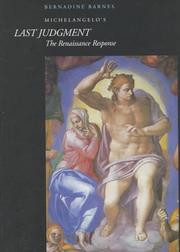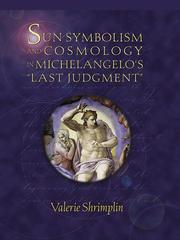| Listing 1 - 8 of 8 |
Sort by
|

ISBN: 0520205499 Year: 1998 Publisher: Berkeley, Calif. University of California Press
Abstract | Keywords | Export | Availability | Bookmark
 Loading...
Loading...Choose an application
- Reference Manager
- EndNote
- RefWorks (Direct export to RefWorks)
Judgment Day in art. --- Michelangelo --- Buonarroti, Michelangelo

ISBN: 0943549655 9780943549651 Year: 2000 Publisher: Kirksville (Miss.): Truman State University Press,
Abstract | Keywords | Export | Availability | Bookmark
 Loading...
Loading...Choose an application
- Reference Manager
- EndNote
- RefWorks (Direct export to RefWorks)
Cosmology in art. --- Symbolism in art. --- Judgment Day in art.
Book
Year: 1959 Publisher: Reykjavík : Almenna Bókafélagiđ,
Abstract | Keywords | Export | Availability | Bookmark
 Loading...
Loading...Choose an application
- Reference Manager
- EndNote
- RefWorks (Direct export to RefWorks)
Multi
ISBN: 0824019881 9780824019884 Year: 1976 Publisher: New York (N.Y.) Garland
Abstract | Keywords | Export | Availability | Bookmark
 Loading...
Loading...Choose an application
- Reference Manager
- EndNote
- RefWorks (Direct export to RefWorks)
Christian church history --- Iconography --- anno 1500-1599 --- Judgment Day in art --- Art and religion --- Reformation in art --- Jugement dernier dans l'art --- Art et religion --- Réforme dans l'art --- -Reformation in art --- -Judgment Day in art --- Reformation in art. --- Judgment Day --- Christian art and symbolism --- Art --- Arts in the church --- Religion and art --- Religion --- Religious aspects --- Judgment Day in art. --- Réforme dans l'art --- Art and religion - - Europe, Northern
Book
ISBN: 1442697601 9781442697607 9780802098092 0802098096 1487530609 9781487523411 1487523416 9781487530600 Year: 2009 Publisher: Toronto
Abstract | Keywords | Export | Availability | Bookmark
 Loading...
Loading...Choose an application
- Reference Manager
- EndNote
- RefWorks (Direct export to RefWorks)
"Few subjects in Christianity have inspired artists as much as the Last Judgment. Last Judgment Iconography in the Carpathians examines over 100 images of the Last Judgment, with an emphasis on those from the fifteenth century to the eighteenth century, in the Carpathian mountain region of Ukraine, Poland, Slovakia, and Romania. John-Paul Himka's analysis of these monumental works of art allows him to consider history free from the traditional frameworks and narratives of nations. For nine years, Himka studied Last-Judgment images throughout the Carpathians and found a distinctive and transnational blending of Gothic, Byzantine, and Novgorodian art in the region." "Piecing together the story of how these images were produced and how they developed, Himka traces their origins on linden boards and their evolution on canvas and church walls. Originally painted by monks, these images increased in popularity and eventually came to be commissioned and even painted by peasants and shepherds whose tastes so shocked bishops that they ordered the destruction of depictions of sexual themes and grotesque forms of torture. A richly illustrated and detailed account of history through a style of art, Last Judgment Iconography in the Carpathians will find a receptive audience with art historians, religious scholars, and Slavists."--Jacket.
Judgment Day in art. --- Apocalypse in art. --- Icons --- Eikons --- Ikons --- Christian art and symbolism --- Christian saints in art --- Judgment Day --- History. --- Christianity and art --- Orthodox Eastern Church. --- History --- Carpathian Mountains Region --- Religious life and customs.

ISBN: 0271021403 Year: 2003 Publisher: University Park Pennsylvania State university press
Abstract | Keywords | Export | Availability | Bookmark
 Loading...
Loading...Choose an application
- Reference Manager
- EndNote
- RefWorks (Direct export to RefWorks)
Book
ISBN: 9780367898502 0367769018 0367898500 9780367769017 9781003021445 Year: 2021 Publisher: Abingdon Routledge
Abstract | Keywords | Export | Availability | Bookmark
 Loading...
Loading...Choose an application
- Reference Manager
- EndNote
- RefWorks (Direct export to RefWorks)
"Experiencing the Last Judgement opens up new ways of understanding a Byzantine image type that has hitherto been considered largely uniform in its manifestations and to a great extent frightening, coercive and paralysing. It moves beyond a purely didactic understanding of the Byzantine image of the Last Judgement, as a visual eschatological text to be 'read' and learned from, and proposes instead an appreciation of each unique image as a dynamic site to be experienced. Paintings, icons and mosaics from the tenth to the fourteenth century, from inside and outside of the Byzantine Empire, are placed within their specific socio-historical milieus, their immediate decorative programmes and their architectural contexts to demonstrate that each unique image constituted a carefully orchestrated and immersive experience of judgement. Each case study outlines the differences that exist in reality between these images that are often subsumed under one iconographic label, making a case against condensing dynamic, lived images into apparently static pictorial 'types'. Images of the Last Judgement needed the body, mind and memory of the viewer for the creation of meaning, and so the experience of these images was unavoidably spatial, gendered, corporeal, mnemonic, emotional, rhetorical and most often liturgical. Unpacking Byzantine images of judgement in light of these various facets of experience for the first time helps to elucidate the interaction of past individuals with the image, and the ways in which such encounters were intended to benefit the communities that made and lived alongside them"--
Judgment Day in art --- Art, Byzantine - Themes, motives --- Art and society - Byzantine Empire --- Art, Byzantine --- Art and society --- Themes, motives --- Art --- Art and sociology --- Society and art --- Sociology and art --- Byzantine art --- Art, Medieval --- Christian art and symbolism --- Judgment Day --- Social aspects

ISBN: 0918720613 0918720605 Year: 1985 Publisher: Kalamazoo, MI : Medieval Institute Publications,
Abstract | Keywords | Export | Availability | Bookmark
 Loading...
Loading...Choose an application
- Reference Manager
- EndNote
- RefWorks (Direct export to RefWorks)
Comparative literature --- Drama --- Iconography --- Literary semiotics --- Thematology --- anno 500-1499 --- 7.046.3 --- Iconografie: religieuze voorstellingen --- 7.046.3 Iconografie: religieuze voorstellingen --- Art and literature --- Christian art and symbolism --- Christian drama, English (Middle) --- English drama --- Judgment Day in art --- Judgment Day in literature --- Mysteries and miracle-plays, English --- Judgment Day --- Art, Christian --- Art, Ecclesiastical --- Arts in the church --- Christian symbolism --- Ecclesiastical art --- Symbolism and Christian art --- Religious art --- Symbolism --- Church decoration and ornament --- Literature and art --- Literature and painting --- Literature and sculpture --- Painting and literature --- Sculpture and literature --- Aesthetics --- Literature --- History and criticism --- Symbolism in art --- ICONOGRAPHIE --- JUGEMENT DERNIER --- MOYEN AGE
| Listing 1 - 8 of 8 |
Sort by
|

 Search
Search Feedback
Feedback About UniCat
About UniCat  Help
Help News
News